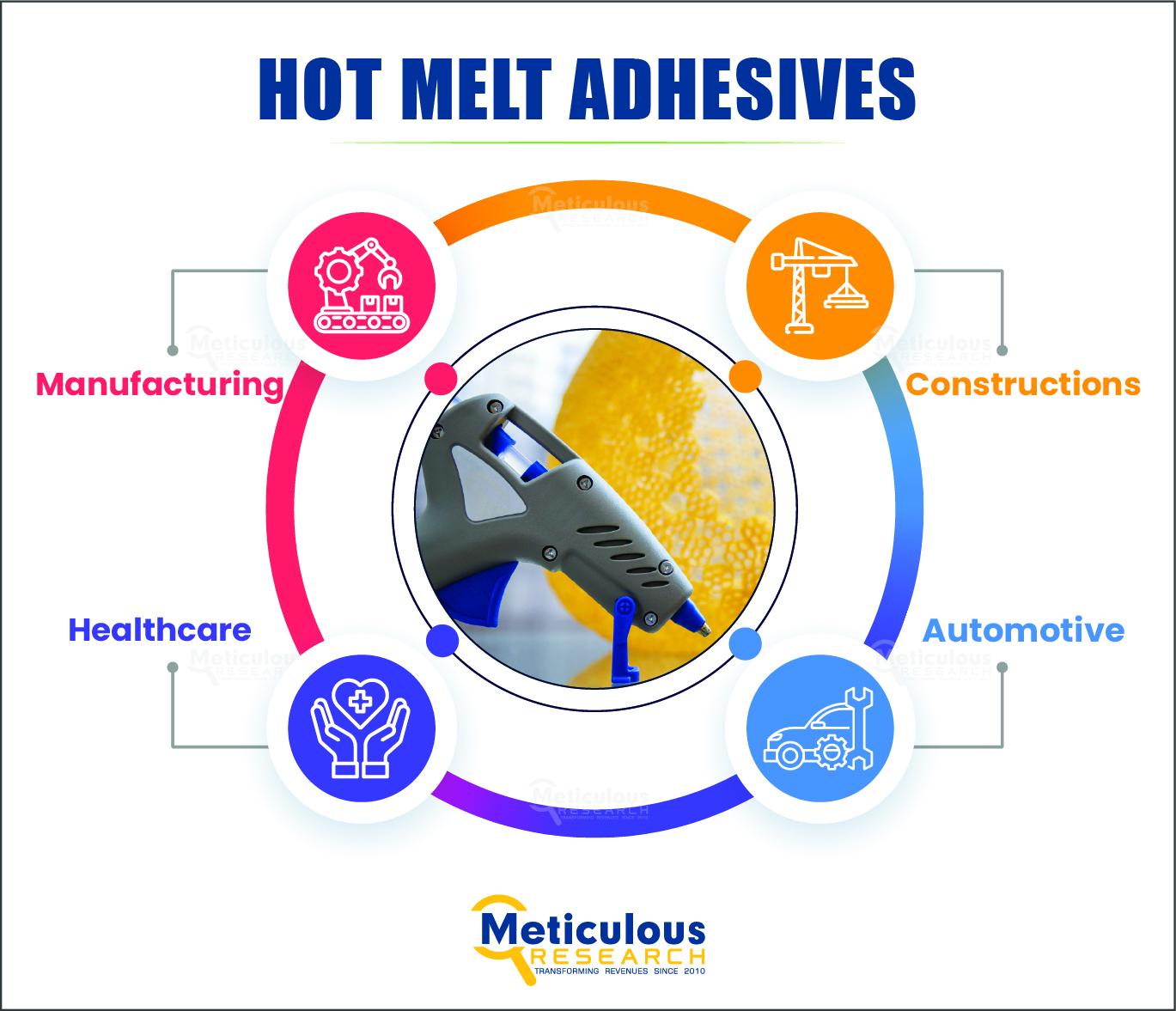Meticulous Research® has recently released a detailed report titled "Hot Melt Adhesives Market by Type (EVA, Polyolefin, Polyurethane, Others), Form (Solid, Granular/Powder, Others), End-use Industry (F&B, Automotive, Electronics, Home Decor, Consumer Goods, Textile, Others), and Geography - Global Forecast to 2031." According to this report, the global hot melt adhesives market is expected to grow to $12.8 billion by 2031, with a CAGR of 5.1% from 2024 to 2031. The market's growth is driven by technological advancements in raw materials and a rising demand for innovative packaging solutions. However, challenges such as the lower thermal resistance of hot melt adhesives may limit market expansion.
Download Sample Report Here @ https://www.meticulousresearch.com/download-sample-report/cp_id=5984
Despite these challenges, significant growth opportunities exist, particularly in the development of sustainable hot melt adhesives and their expanding use in non-woven materials. However, the rising prices of raw materials are expected to pose a significant challenge, potentially impacting market growth.
The market is segmented by type, including ethylene vinyl acetate (EVA), polyamide (PA), polyurethane, polyolefin, styrenic block copolymers (SBCS), amorphous poly alpha olefins (APAO), metallocene, and other types. Among these, the EVA segment is anticipated to lead the market in 2024, accounting for over 39.0% of the global market share. This segment's dominance is attributed to EVA's excellent adhesive properties, its versatility in bonding a wide range of materials, and its extensive application in industries such as packaging, mattress production, woodworking, product assembly, and automotive manufacturing.
EVA’s superior adhesive performance makes it a preferred choice in various industrial applications. As technology advances, EVA hot melts are expected to see increased demand, particularly as ongoing research focuses on improving their temperature resistance and adhesion to more challenging substrates.
The market is also segmented by form into solid, granular/powder, and viscous liquid. The solid segment is expected to hold the largest market share, surpassing 42.0% in 2024. The segment's dominance is due to the numerous advantages of solid hot melt adhesives, including ease of application, long shelf life, minimal waste, and the elimination of the need for mixing or specialized equipment. Moreover, the solid segment is projected to register the highest growth rate during the forecast period.
When segmented by end-use industry, the market includes automotive, electronics, home decor, textile, food & beverage, healthcare & pharmaceutical, consumer goods, construction, fashion & apparel, manufacturing, and other sectors. The food & beverage segment is expected to lead the market, accounting for over 33.0% of the global market share in 2024. This segment's growth is driven by the increasing demand for safe packaging solutions, the extensive application of hot melt adhesives in sealing cartons, boxes, and pouches, and the growing trend towards sustainable, bio-based adhesive technologies.
However, the automotive segment is expected to achieve the highest CAGR during the forecast period, driven by the adoption of high-speed automated production lines, the increasing use of hot melt adhesives for interior vehicle lamination, and the demand for strong adhesives in assembling various automotive components.
Geographically, the market is segmented into North America, Europe, Asia-Pacific, Latin America, and the Middle East & Africa. The Asia-Pacific region is projected to dominate the global market, with over 48.0% of the market share in 2024. This dominance is attributed to rapid industrialization, a strong presence of automotive manufacturers, and a large number of furniture manufacturers in the region.
Furthermore, the Asia-Pacific region is expected to register the highest CAGR of 6.5% during the forecast period. This growth is driven by increased demand for hot melt adhesives in packaging, labeling, product assembly, woodworking, and textile applications, coupled with the region's growing emphasis on sustainability in response to environmental concerns.
Key Players:
Some of the key players operating in the hot melt adhesives market are H.B. Fuller Company (U.S.), 3M Company (U.S.), Jowat SE (Germany), Henkel AG & Co. KGaA (Germany), Arkema (France), The Dow Chemical Company (U.S.), Sika AG (Switzerland), Avery Dennison Corporation (U.S.), Tex Year Industries Inc. (Taiwan), Huntsman Corporation (U.S.), KLEIBERIT SE & Co. KG (Germany), Power Adhesives Ltd. (U.K.), Evans Adhesive Corp. (U.S.), Wacker Chemie AG (Germany), and Paramelt B.V. (Netherlands).
To gain more insights into the market with a detailed table of content and figures, click here: https://www.meticulousresearch.com/product/hot-melt-adhesives-market-5984
Key Questions Answered in the Report:
- Which are the high-growth market segments based on type, form, and end-use industry?
- What was the historical market for hot melt adhesives?
- What are the market forecasts and estimates for the period 2024–2031?
- What are the major drivers, restraints, and opportunities in the hot melt adhesives market?
- Who are the major players, and what shares do they hold in the hot melt adhesives market?
- How is the competitive landscape in the hot melt adhesives market?
- What are the recent developments in the hot melt adhesives market?
- What are the different strategies adopted by the major players in the hot melt adhesives market?
- What are the key geographic trends, and which are the high-growth countries?
- Who are the local emerging players in the global hot melt adhesives market, and how do they compete with the other players?
Contact Us:
Meticulous Research®
Email- sales@meticulousresearch.com
Contact Sales- +1-646-781-8004
Connect with us on LinkedIn- https://www.linkedin.com/company/meticulous-research



